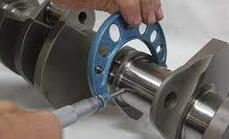What is bearing clearance?In simple terms, bearing clearance is the clearance (or interference) within a single bearing or a system composed of several bearings.Clearance can be divided into axial clearance and radial clearance, depending on bearing type and measurement method.
Why should the bearing clearance be adjusted?For example, too much or too little water when cooking rice will affect the taste of the rice.Similarly, the bearing clearance is too large or too small, the working life of the bearing and even the stability of the entire equipment operation will be reduced.
Bearing types for different adjustment methods.The method of clearance adjustment depends on the type of bearing, which can be generally divided into non-adjustable bearing and adjustable bearing.The clearance of non-adjustable bearings refers to that the clearance of bearings is determined after they leave the factory. Deep groove ball bearings, aligning bearings and cylindrical bearings, which we are familiar with, belong to this class.Adjustable clearance bearings refer to the relative axial position of the bearing raceway that can be moved to obtain the required clearance. Tapered bearings, angular contact ball bearings and some thrust bearings belong to this class.
Factors affecting bearing clearance.The choice of the optimal operating clearance is determined by the application conditions (load, speed, design parameters) and the expected operating conditions (maximum life, best stiffness, low heat generation, ease of maintenance, etc.).However, in most applications, it is not possible to adjust the working clearance directly, which requires us to calculate the appropriate post-installation clearance based on application analysis and experience.
Clearance adjustment is the key technology of INA bearing installation and adjustment, which is related to the running state of bearing and even the whole equipment.The clearance adjustment method reflects the real effort of bearing enterprises in a fraction of a cent.






